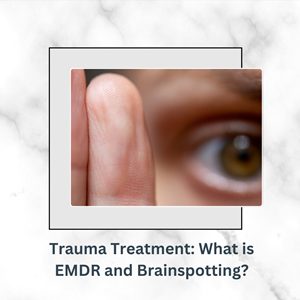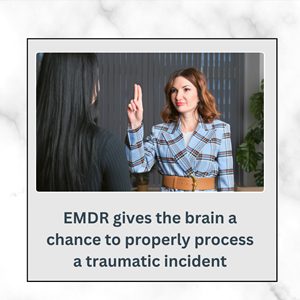 As anyone who’s experienced any form of trauma knows, it lingers. The fear response, the flashbacks and the nightmares insist on sticking around, casting a shadow over everything.
As anyone who’s experienced any form of trauma knows, it lingers. The fear response, the flashbacks and the nightmares insist on sticking around, casting a shadow over everything.
There’s a line in the sand separating life before and life after the incident.
Most of us—no matter who we are or what we have—are going to experience at least one significant trauma during this lifetime, probably more.
The good news for those who’ve already experienced it is there’s something you can do about it: EMDR and Brainspotting are two of the leading modalities showing favorable outcomes in treating PTSD.
But what are they, and how do they help?
Let’s take a closer look.
What is Brainspotting?
Discovered in 2003 by Dr. David Grant, Brainspotting involves locating points visually that help access unprocessed trauma, release it, and heal.
What Happens During a Brainspotting Session?
Each point in a client’s field of vision is associated with a particular “brain spot” in the subcortical region of the brain that holds on to thoughts and emotions.
When a client lands on a challenging brain spot, a point in their field of vision where discomfort increases, that indicates further exploration is necessary.
The therapist will use a light, a rod, or some other pointer device as a means to help the client retain visual focus, and explore and process the feelings that arise.
There are two common approaches: outside window means the therapist is observing the visual gaze and using that observation to recommend a visual point to focus on, and inside window relies on the client to choose one themselves.
Because Brainspotting is still relatively new the research isn’t too robust, it doesn’t contain the longevity of other studies. However, the research that has been done is promising, and indicates favorable results when treating PTSD, as well as anxiety and depression.
What is EMDR?
 Eye Movement Desensitization and Reprocessing (EMDR) is something that Dr. Francine Shapiro devised in the 1980s. She had a hunch that the brain stored traumatic situations differently, and wanted to help alleviate some of the residual lingering affects her patients were faced with after a traumatic incident.
Eye Movement Desensitization and Reprocessing (EMDR) is something that Dr. Francine Shapiro devised in the 1980s. She had a hunch that the brain stored traumatic situations differently, and wanted to help alleviate some of the residual lingering affects her patients were faced with after a traumatic incident.
During an EMDR session, clients are instructed to engage in some form of bi-lateral movement (which usually looks like moving their eyes back and forth) while discussing and processing a challenging experience.
How Does EMDR Help You Heal from Trauma?
The bi-lateral stimulation helps reduce the vividness and intensity of the emotional experience surrounding the event. EMDR gives the brain a chance to properly process a traumatic incident, and smooth out the memory so it doesn’t feel like such a disruption or “glitch” in the system.
EMDR is structured, and rather than go into grave detail about how distressing the situation was, the focus is on reframing the emotions, thoughts and behaviors that linger after a disturbing incident.
At the Relationship Therapy Center, we utilize both approaches. The great thing about having different treatment modalities is your therapist can find one that works well for you. If you or a loved one have recently experienced something horrible that’s completely thrown you for a loop, or if you’re anxious, depressed, or generally off, give us a call. We have two locations where we provide counseling and trauma treatment in Roseville and Fair Oaks.
Want a more in-depth explanation? Please feel free to reach out anytime. We’re always happy to answer any questions, and share more about how we can help.
Begin Trauma Therapy in the Sacramento Area or Online:

Are you ready to find peace and healing after trauma? We are here to support you and provide high-quality evidence-based trauma treatment to people in the Sacramento Area and online for people living in the state of California. To begin trauma therapy in Fair Oaks, CA or Roseville, CA, please follow these steps:
- Reach out to our relationship therapy clinic for a free 15-minute phone consultation to learn more about trauma therapy.
- Meet with one of our compassionate trauma therapists.
- Begin trauma treatment and regain control in your life.
Other Services Offered at The Relationship Therapy Center in California:
In addition to trauma therapy, Our Sacramento area counseling clinics located in Roseville and Fair Oaks, CA are pleased to offer a variety of mental health services. Our couples services include: Counseling after infidelity, sex therapy, co-parent counseling, family therapy, divorce counseling, intensive couples retreats, and premarital counseling. Our individual therapy services include, therapy for children, teen therapy, depression treatment, and individual relationship counseling. Our therapists offer online counseling in California to treat a variety of mental health concerns. Please reach out to our Sacramento area therapy office to learn more about the many ways we can help you or your loved ones heal and grow.
